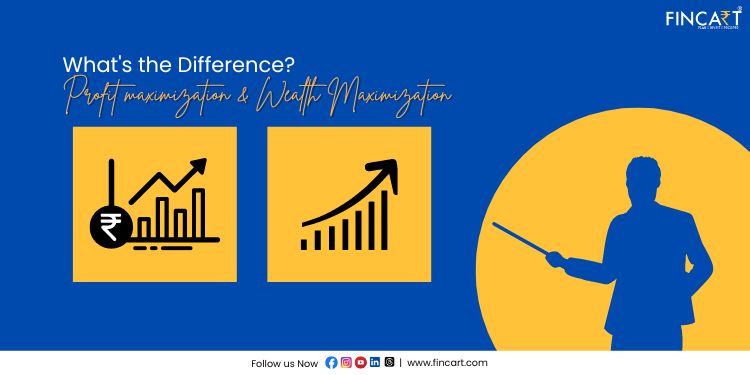Table of Contents
ToggleProfit maximisation and wealth maximisation are two major objectives of financial management. While profit maximisation strategies focus on generating profit in the short term, wealth maximisation strategies aim to increase the share value of the company for the shareholders over the long term. Let’s learn the difference between profit maximization vs wealth maximization in financial management, and what each strategy means for a company’s success.
Difference Between Profit Maximization And Wealth Maximization
Profit maximization focuses on boosting a company’s earnings, while wealth maximization is geared toward enhancing the overall value of the entity. While profit maximization is often seen as a primary goal, as it reflects operational efficiency, wealth maximization seeks to increase the value for stakeholders, ensuring long-term growth and sustainability.
| Basis | Profit Maximization | Wealth Maximization |
| Goal | The main goal of profit maximisation is to maximise a company’s profit by decreasing costs or increasing revenue. It prioritises cutting costs and immediate profit generation. | The main objective is to maximise the wealth of all shareholders. It encourages strategic investments that may not pay off immediately, but will in the future. |
| Time Horizon | Generally considered a short-term strategy. | Focuses on the long term. |
| Time Value of Money | Does not consider the time value of money. | Considers the time value of money. |
| Sustainability | A company looking to maximise profits may not always make sustainable decisions. | Uses sustainable practices. |
| Flexibility | Not as flexible because the company may not be able to adapt to short-term market conditions. | Allows easy readjustments to strategies based on the company’s long-term goals. |
| Risk | It can be risky to earn immediate profits, so the company must have a high risk tolerance. | The strategies involved tend to be not very risky as the company seeks long-term sustainability. |
| ESG | Environmental, social and governance factors may not be prioritised. | ESG can improve a company’s reputation, ensure regulatory compliance, and build stronger relationships with stakeholders so they are prioritised. |
| Financial Ratios Used | Focus is on metrics like Net Profit Margin, Return on Investment, turnover ratio, and accounts receivable turnover ratio. | Focuses on metrics such as earnings per share, price to earnings (P/E) ratio, and price to book (P/B) ratio. |
| Value Creation | More emphasis is put on immediate earnings. | Emphasis is on increasing the overall value of the company. |
| Maximisation Procedure | Increases the earning capacity of the company. | Increases the value of the company’s stock for shareholders. |
Profit Maximization vs Wealth Maximization
| Characteristics | Profit Maximization | Wealth Maximization |
|---|---|---|
| Definition | Focuses on maximizing short-term profits for the business. | Aims to maximize the overall value of shareholders’ wealth. |
| Time Horizon | Short-term approach. | Long-term approach. |
| Objective | Increase net earnings and revenue. | Enhance the market value of shares and business growth. |
| Focus | Operational efficiency and cost-cutting. | Investment, financial planning, and risk management. |
| Risk Consideration | Ignores risks and uncertainties. | Considers risks and rewards while making decisions. |
| Decision-making | Decisions based on immediate profit impact. | Decisions based on sustainable growth and future value. |
| Measurement | Measured in terms of net profit or earnings per share (EPS). | Measured in terms of stock price and shareholders’ returns. |
| Stakeholder Impact | Prioritizes business owners or shareholders. | Considers shareholders, employees, and society at large. |
| Example | A company cutting R&D expenses to boost short-term profits. | A company investing in innovation for long-term growth. |
Profit Maximisation vs Wealth Maximization Example
Example – Profit Maximisation
Suppose a company wants to maximise its profits. It can do so in many ways, such as:
- It can increase the price of goods or services to boost profit margins. The pricing strategy should always take into account that the market can bear the higher prices without considerable loss of sales volume.
- The company can reduce production costs by using cheaper raw materials, labour, and also negotiate better deals with suppliers.
- It can increase sales by entering new markets and focusing on marketing.
- The company can move to areas with cheaper rents or use machinery that requires less maintenance.
- It can also explore new ways of reaching customers, such as online marketing, e-commerce platforms, and social media engagement.
In the above points, the company is either decreasing the input or increasing the output. In either case, the result is that the company is earning more profits. If the company cuts costs on the raw materials, it can make profits in the short term. But using cheaper materials might also affect the quality of the product which leads to customer dissatisfaction and a damaged reputation. In the long-term, this would result in decreased customer loyalty, lower sales, and negatively impact the company’s profitability.
Example – Wealth Maximisation
If a company wants to focus on making its shareholders wealthier, it can follow these strategies:
- The company can invest in technology that promises sustainable long-term returns rather than short-term gains, and expand its research and development.
- It can improve the quality of its goods and services, and also its customer services. This focus on client satisfaction increases a company’s reputation and builds a strong and loyal customer base.
- Another strategy that can improve a company’s reputation is adopting environmentally and socially responsible practices.
- The company can invest in training its employees to improve their skills and productivity. Well-trained employees are more effective, so the operational efficiency of the company will increase.
- It can focus on ESG (environmental, social, and governance) factors by making transparent and responsible decisions. A well-governed company attracts more shareholders and increases value.
These strategies allow the company to focus on long-term value creation. Suppose the company wants to improve its existing products and launch a new service. That would require significant investment in research and development. Since this will increase the costs, the profits in the short term will decrease. But over the long term, superior quality products and services can increase the company’s reputation and value. So even though initial profits may decline, the shareholder value increases over time.
Profit Maximisation vs Wealth Maximisation: Which Is Better?
Profit maximization in financial management focuses on enhancing a company’s earnings as a measure of its operational efficiency. In contrast, wealth maximization seeks to boost the overall value of the organization, benefiting stakeholders over the long term. While profit maximization addresses short-term gains, wealth maximization is oriented toward sustainable growth, prioritizing shareholder wealth and the entity’s market valuation.
Both approaches have their pros and cons. Without healthy profits, a company cannot sustain its operations, invest in growth, or provide returns to its shareholders. All of these factors contribute to wealth maximization, so in a way, both strategies go hand in hand. A company needs profits to survive, especially so when it is in its early stages. However, focusing only on profits might lead to poor decisions such as cutting costs at the expense of product quality or adopting unethical practices. This can be very harmful to the company’s reputation and long-term sustainability.
For example, if a company uses cheap, low quality materials to make its goods, it will increase short-term profits due to the low cost of production. But the quality of the product might also go down, which will decrease customer satisfaction in the long term. Over time, the product’s reputation might take a hit and it might lose a significant chunk of its customer base. So for most companies, a balanced approach is best.
The choice between the two strategies also depends on the company’s goals. For example, a startup focusing on creating a presence would likely prioritise profit maximisation to make sure it has enough cash flow to sustain its daily operations and achieve quick growth. On the other hand, an established company wanting to be a market leader might focus on wealth maximisation to increase its long-term value and make its shareholders wealthier.
Ready to grow your wealth?
Partner with Fincart for expert investment planning and make your money work for you.
What Is Profit Maximization?
The profit earned by a company is given by subtracting the total cost from the total revenue it generates. So the two main ways a company can increase profit is by either increasing the output or by decreasing the input. Profit Maximization is a strategy that helps a company earn the maximum possible revenue at minimum costs. A company that wants to maximise its profits will make the amount of product where the cost of making one more unit (marginal cost) is the same as the revenue from selling one more unit (marginal revenue). This is done by implementing different strategies, like deciding the optimal price for goods or services, changing the production process to reduce costs, using cheaper materials and labour, cutting down overhead costs, improving sales techniques to increase sales, and managing resources efficiently.
What Is Wealth Maximization?
Compared to profit maximisation, wealth maximisation is a modern approach. It doesn’t just focus on short-term profits but rather, aims to make various stakeholders of the company wealthier in the long term by aiming to increase the overall value of a company through stock market value (earnings per share and capitalisation rate). Wealth Maximization aims to create lasting value. It focuses on much broader factors, such as the quality of goods and services, the company’s reputation, customer satisfaction, innovation, and strategies that promote sustainable growth.
FAQ
1. What are the advantages of wealth maximization over profit maximization?
Wealth maximization focuses on increasing the overall value of the firm, which considers long-term growth and sustainability. It encourages better resource allocation and aligns management with shareholder interests, unlike profit maximization, which may prioritize short-term gains at the expense of long-term stability.
2. What is the impact of risk on profit maximization vs. wealth maximization?
Profit maximization often overlooks risk, leading to potentially volatile short-term gains, while wealth maximization incorporates risk assessment into decision-making, focusing on strategies that enhance the company’s value over time.
3. What role do dividends play in profit maximization vs. wealth maximization?
In profit maximization, dividends may be viewed as a method to distribute short-term profits, sometimes prioritizing immediate returns over reinvestment. Conversely, wealth maximization emphasizes dividends as a reflection of a company’s long-term health and ability to generate sustainable value for shareholders.
4. How do investment decisions differ under profit and wealth maximization goals?
Under profit maximization, investment decisions may prioritize projects with quick returns, while wealth maximization focuses on investments that offer sustainable growth and higher long-term value for shareholders.
5. What strategies can companies adopt to balance profit maximization with long-term growth?
Companies can focus on sustainable cost management, invest in innovation, maintain ethical business practices, and ensure customer satisfaction. Diversification of revenue streams, long-term financial planning, and employee development also help balance immediate profits with future growth.
6. What are the key advantages of wealth maximization over profit maximization?
Wealth maximization ensures long-term financial stability, reduces risk, and enhances shareholder value. It promotes ethical decision-making, sustainable growth, and stakeholder welfare, making it a more holistic and responsible financial objective.
7. Explain the concept of Profit Maximization and Wealth Maximization?
Profit maximization focuses on increasing short-term earnings by boosting revenue and cutting costs, often ignoring long-term impacts. Wealth maximization, on the other hand, aims to enhance shareholder value by considering sustainable business growth, risk management, and long-term profitability.




